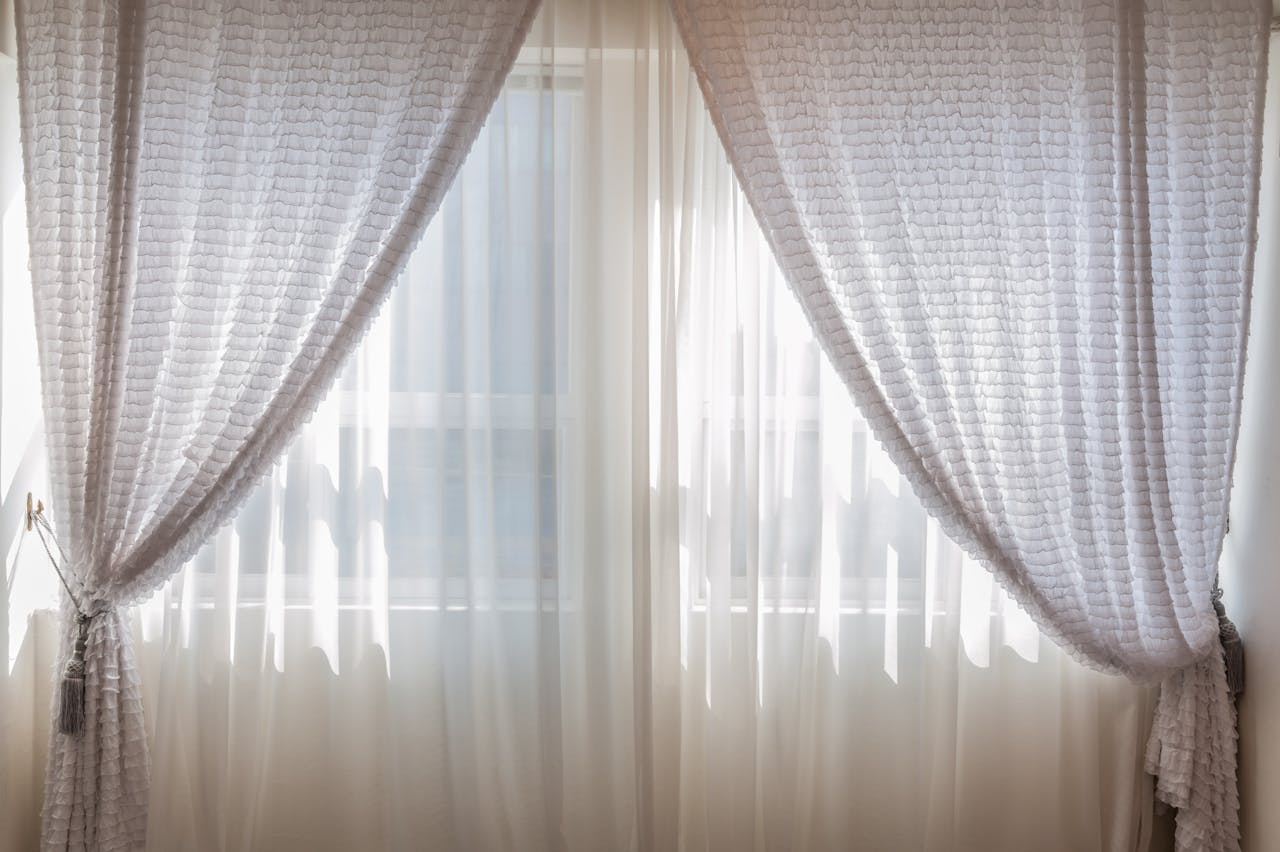
How to Choose Curtains for Bedroom: A Step-by-Step Guide
Crafting the perfect ambiance in your bedroom extends beyond choosing the right furniture and décor; it significantly involves how to choose curtains for the bedroom. This seemingly simple decision can impact both the aesthetic appeal and functionality of your space — from controlling the amount of light that enters your room to ensuring your privacy and even enhancing your overall décor scheme. Bedroom curtains not only contribute to the visual harmony of a room but also embody the personal style and comfort of the inhabitant, making the selection process crucial.
Rely on Joey’z comprehensive walkthrough on mastering the art of selecting the ideal curtains for your bedroom. Beginning with the importance of fabric choices and how they influence the look and feel of the room, to dissecting the spectrum of colors and patterns that can either invigorate or calm the space.
Factors to Consider When Choosing Fabric
Light Control
Selecting the right fabric for bedroom curtains greatly influences how much light can enter the room. Sheer fabric curtains, for example, let in a lot of natural light, creating a bright and peaceful atmosphere. This is ideal for those who prefer a bright and welcoming environment. On the other hand, for those who need darker conditions for sleeping or privacy, blackout curtains are a superior choice. These curtains can block up to 99% of incoming light, making them ideal for bedrooms and nurseries where darkness is essential for restful sleep.
Insulation
The weight and quality of the fabric play a crucial role in its insulating properties, determining how well it can retain heat and block cold air. Heavier fabrics such as velvet and wool are excellent for keeping a room warm in the winter and cool in the summer. Custom drapes, especially when made with high-quality, heavier fabrics, also provide excellent insulation. They are designed to fit perfectly, covering every corner of the window, which is essential for preventing heat loss.
Aesthetics
The appearance of the curtains is just as important as their functional attributes, as they need to complement the overall aesthetic of the room while providing necessary features like light control and insulation. Cotton and linen offer a light, clean look that can complement any room décor, adding a touch of elegance and sophistication. Velvet, known for its luxurious texture, adds warmth and richness to a room’s aesthetic, enhancing its overall appeal. When choosing curtains, consider how the fabric’s color, texture, and pattern will integrate with the existing room décor to create a harmonious look.
Understanding Curtain Colors and Patterns
Color Coordination
Choosing the right curtain colors is essential for achieving a harmonious bedroom environment. One should consider the mood and style of the room—whether it's formal or relaxed, classic or modern. For a cohesive look, curtains that are slightly darker than the walls or that pick a subtle, non-dominant color in the room can create a soft, unified appearance. This approach suits almost any decorating scheme. In contrast, for rooms bathed in sunlight, selecting curtains in bright colors can enhance the vibrancy but may lead to fading over time. It’s also beneficial to match the curtain color with other elements like furniture and rugs to maintain the room's aesthetic balance.
Patterns vs. Solids
When deciding between solid and patterned curtains, consider their long-term appeal and impact on room design. Solid curtains are a safe choice, staying in style longer and offering flexibility in changing room decor without clashing with existing patterns. They are also generally less expensive as they require less fabric and labor to produce. On the other hand, patterned curtains provide a unique, custom-made look that can set the color palette for the entire room. However, they should be avoided if the room already contains patterned wallpaper or furnishings to prevent a visually overwhelming environment.
Impact of Sunlight
The color of the curtains not only influences the aesthetic but also affects how light is filtered into the room. Light-colored curtains, such as whites and neutrals, reflect more light, making a room feel larger and more open, whereas dark-colored curtains can make a spacious room feel cozier and more intimate. It's important to consider the direction the room faces; north-facing rooms might benefit from warm-colored curtains to enhance the natural light, while south-facing rooms could use cooler tones to moderate the brightness. Additionally, well-lined curtains can provide both light blocking and thermal benefits, making them a practical choice for varying light conditions throughout the year.
Different Curtain Styles and Their Benefits
Exploring the variety of curtain styles available can significantly impact the aesthetic and functionality of a bedroom. Each curtain style offers distinct advantages, catering to different tastes and functional needs. Whether you need light control, insulation, or aesthetic enhancement, there's a style to suit every preference and requirement.
Traditional vs. Modern Styles
Traditional curtain styles, such as pinch pleats and swags, are known for their tailored appearance and classic appeal. Pinch pleats, sewn together at the top, create a structured look that enhances the room's elegance. Swags, often used as decorative enhancements, drape gracefully over a rod, adding a touch of sophistication without compromising functionality.

Of course, modern styles like valance curtains that are grommeted lend a sleek and contemporary look. Grommets involve metal rings along the top that facilitate easy sliding and a clean line, while ripple folds offer a smooth, consistent pleating that complements modern decor. These styles are particularly effective in rooms that feature minimalist or modern furniture and design elements.
Casual vs. Formal
The choice between casual and formal curtain styles can significantly alter a room's ambiance. Casual styles create a relaxed, inviting feel, while formal curtains add elegance and sophistication. Casual styles, such as tab-top curtains, are characterized by their relaxed look and ease of use. Fabric loops allow for straightforward hanging on rods, making them ideal for informal settings or rooms with a laid-back style.
Formal curtain styles, such as box pleats and Euro-pleated drapes, provide a more polished look. Box pleats create a deep fold down the curtain's length, offering a crisp, clean appearance that suits formal or traditional interiors. Euro-pleated drapes, pinched at the top and flowing freely at the bottom, strike a balance between formal elegance and modern simplicity, making them suitable for transitional spaces.
Each curtain style brings its unique flavor to a room, influencing both its aesthetics and how it functions day-to-day. Whether aiming for a light, airy feel with sheer fabrics or seeking more privacy and light control with heavier materials, the right curtain style can make all the difference in crafting a personalized space that feels both comfortable and stylish.
Selecting and Using Curtain Hardware
Types of Curtain Rods
Selecting the right curtain rod is crucial for both the functionality and aesthetics of your bedroom curtains. The right rod will ensure smooth operation while complementing the room's decor, enhancing the overall look and feel of the space. The most common types include decorative, double rods, and tension rods. Decorative rods are visible and come in various designs to complement your decor, while double rods allow for layering of curtains, offering versatility in style and light control. Tension rods are excellent for easy installation without the need for tools, ideal for renters or temporary setups.

Tiebacks and Holdbacks
Tiebacks and holdbacks are essential for adding structure and elegance to your curtains. They help manage light and privacy by holding curtains back, contributing to the overall neat appearance of the room. Holdbacks are usually fixed and made of materials like metal or wood, providing a durable solution. Tiebacks, on the other hand, offer decorative flexibility and can be made from soft materials such as ropes or fabrics, perfect for adding a touch of style.

Using Liners
Liners are an important addition to any curtain setup, enhancing privacy, insulation, and light control. They come in various types such as blackout, privacy, and interlining. Blackout liners are perfect for bedrooms, blocking up to 99% of incoming light for better sleep quality. Privacy liners prevent views from outside while still allowing some light to filter through, and interlining adds a layer of insulation, helping to maintain room temperature and adding fullness to the curtains.
Incorporating the right hardware and accessories can significantly enhance the functionality and style of your bedroom curtains, ensuring they not only look great but also serve their intended purpose effectively.
Layering and Combining Curtains
Layering curtains offers a dynamic approach to enhance both the aesthetic and functionality of bedroom windows. This technique not only introduces depth and texture to the space but also provides improved light control and increased privacy.

Using Multiple Layers
The most effective method to layer curtains involves using a double curtain rod or a track system, allowing for seamless functionality of each layer. Typically, lighter, sheer curtains are hung closest to the window on the inner rod. This placement allows natural light to enter while maintaining a level of privacy, creating a bright yet private atmosphere in the room. The outer rod generally supports heavier drapes, possibly with blackout or privacy lining, which can be drawn to completely block light or opened to reveal the sheer layer. For those seeking a sophisticated design, layering sheer drapes with embroidered patterns behind a heavier curtain can create a delicate play of light and texture, adding an element of elegance to the bedroom.
Combining Curtains with Blinds
Integrating blinds with curtains opens up numerous possibilities for both style and functionality. This combination is particularly beneficial for controlling light and enhancing privacy without compromising on style, allowing you to enjoy both a functional and aesthetically pleasing space. Blinds offer a neat and controlled appearance, which can be softened with the textural contrast of curtains. For a cohesive look, it’s advisable to select blinds in a neutral tone or a solid color that completes the curtains. This setup not only adds depth to the room but also allows for versatile light management—blinds can be adjusted for privacy and light, while curtains add a touch of softness and décor.
In both setups, it's essential to consider the hardware involved. Double rods and track systems should be chosen not only for their functionality but also for their ability to blend with the room's overall design. Decorative finials and tiebacks can serve as both functional elements and decorative pieces, enhancing the layered look while providing practical benefits like easy curtain maneuvering.
Let’s Wrap Things Up!
Selecting the ideal curtains for your bedroom is easy with the diverse selection from Joey’z Shopping. Along the way, don’t overlook the importance of fabric choices. The right materials can significantly influence both the room's aesthetic and its functional capacity. Choosing the appropriate fabric can enhance the room's style while providing benefits such as insulation, light control, and privacy.
Of course, color and pattern considerations have been intricately tied to the same, revealing how these elements can transform the interior's ambiance. What’s more, understanding the implications of different curtain styles and the corresponding hardware adds another layer of personal touch to your space, ensuring that the final setup not only looks appealing but feels uniquely yours.
Ready to spruce up your bedroom’s interior? Shop our Collection of Curtains today!

